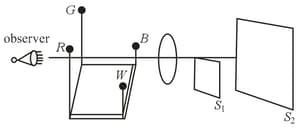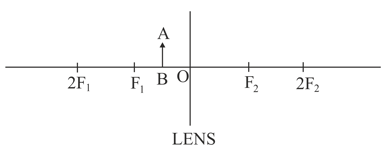The
image is always inverted.
Important Questions on Light

A virtual, diminished image is formed when an object is placed between the optical centre and the principal focus of a lens.
(i) Name the type of lens which forms the above image.
(ii) Draw a ray diagram to show the formation of the image with the above stated characteristics.
Four bulbs; red, green, white and blue (denoted by and respectively) are kept in front of a converging lens (as shown in the figure below). The observer sees that the green and blue bulbs are kept to the left of the principle axis while the red and white bulbs are kept to the right of the principle axis. He also sees that the red and green bulbs are above the principle axis while the white and blue bulbs are below the principle axis. The screens and are set at appropriate positions for the focusing to view the images.

Choose the figure that correctly represents the images as seen by the observer.
An object is placed at a distance in front of a convex lens of focal length .
(i) Calculate the distance of the image from the lens.
(ii) Calculate the magnification of the image.
When a drop of water is introduced between the glass plate and plano convex lens in Newton's rings system, the ring system:
An object is placed between and on the principal axis of a converging lens as shown in the diagram.

Copy the diagram and by using three standard rays starting from point , obtain an image of the object .
The word KVPY is written on board and viewed through different lenses such that board is at a distance beyond the focal length of the lens.

Ignoring magnification effects, consider the following statements.
First image has been viewed from the planar side of a plano-concave lens and second image from the planar side of a plano-convex lens.
First image has been viewed from the concave side of a plano-concave lens and second image from the convex side of a plano-convex lens.
First image has been viewed from the concave side of a plano-concave lens and second image from the planar side of a plano-convex lens.
First image has been viewed from the planar side of a plano-concave lens and second image from the convex side of a plano-convexlens.
Which of the above statements are correct?

